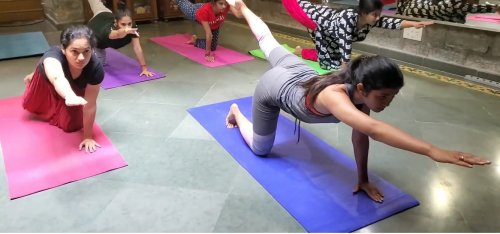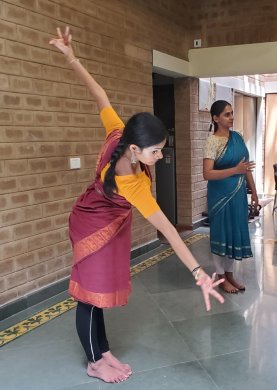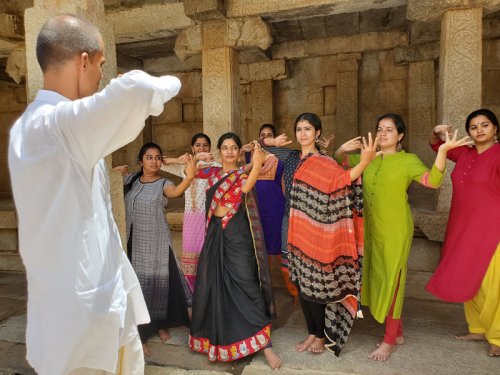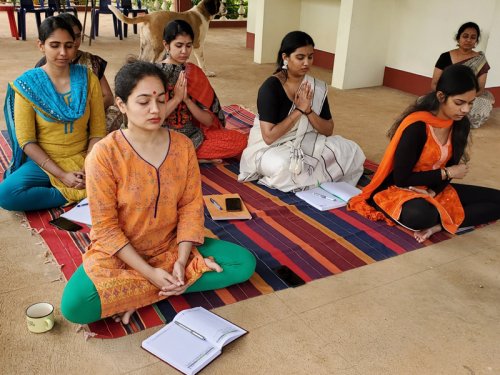
|   |

|   |
Melbourne to Bangalore: In search of something and someone more - Sneha Rajagopalan e-mail: SnehaR@djhs.org.au Photos courtesy: Ambalam August 5, 2019 Where I live, the lifestyle and teaching style dictated that dance be just one small aspect of my life. It was one extracurricular weekend activity out of the numerous others that I participate in. My soul on the other hand, which has probably carried the desire of dancing across many births, wished that it took up at least half of my life. There was something more I needed and I wasn't getting it. I yearned for someone to guide me in taking my art form to another level instead of just teaching me to dance. I craved for someone to remove inhibitions instead of adding more restrictions to my dance. My heart desired a Guru in its truest essence instead of a dance teacher. Here, began my search for that 'something and someone more'. How I found Indira Kadambi was a 'by chance' phenomenon. I like to think that the universe had seen me suffer enough and made me click my way to her Instagram profile. On 25th May 2019, Kadambi posted about the application process for the July month long intensive dance workshop. If you were hanging off the edge of a cliff and someone threw you a rope, how fast would you grab it? Yes, I did that. Work only approved two weeks leave but I was ready to take even half of a rope at that stage. On 30th June I landed in Bangalore. Naturally my family were worried about how I would travel to an unknown place alone but Indira Kadambi had arranged for a known taxi driver to wait for me, pick me up and drop me off at Ambalam. I arrived at Ambalam at 4am. Ramprasadh, her musician husband, greeted me, carried my suitcase, showed me around the studio and even boiled water for me (this would become a little running joke during the trip as my delicate Australian body wouldn't approve of Indian drinking water). The excitement of the workshop woke me up an hour and a half ahead of schedule. Kadambi set up this workshop knowing what a dancer needs. The timetable took a very holistic form to ensure that every aspect of learning, performing and teaching Bharatanatyam was covered in the one month. Our day started early morning at 7am with sessions in yoga and workout. Our workout sessions with Madhumanthi Banerjee, a fitness freak and who herself is a good dancer, was intensive: "Hold your core!", "don't give up!", "come on, 10 more!", "you are stronger than you think", "be the master of your mind" and on the other end was us, wincing in pain, huffing, puffing and sweating. Yet we were determined to keep doing better. The exercises consisted of stretches, surya namaskars, squat pulses, lunge kicks, elbow planks, push-ups, glute strengthening and breathing exercises. The most interesting and important thing was that the exercises were always in line with what we needed to work on in our dancing. For example, one day we found it difficult to achieve the perfect mettu (balancing the body on the toes with the heels raised). So, the following day, we did 3 sets of 10 repetitions of calf raises. Another day, we seemed to have excessive weight shifting of our hips while executing the third speed of thattadavu and naatadavu so the next morning, our workouts consisted of more planks, side planks, plank and hip dips, plank jumps and planks with weight shift. Can you feel the burn? We sure did! Problem with holding natyarambham? Well, in the workshop, there's a workout for that too! Ambalam workouts taught us that the strengthening and conditioning of a dancer's body should always be specific to the problem areas in their dance. This concept, I can say confidently is the basis of any exercise therapy. As a physiotherapist, I knew this theoretically but at Ambalam I applied it practically. To say that the difference it made in adavu class was amazing, would be a massive understatement.  Class with Madhumanthi Banerjee The adavu sessions under Kadambi's supervision highlighted something very noteworthy. Historically, dancers did not give much thought about body alignment. However, people nowadays are dancing with more body awareness and body endurance. "We will only progress in our art form if we too accept and adapt to the changes over time like a river". This one statement was enough to change my perspective on why I should care about kuluku, mettu or the 'core'.  After lunch, we had a couple of hours to consolidate the lessons from that morning. The evening nritha composition sessions tested our understanding of taalam and kanaku in the context of choreographing a korvai. We selected the Saveri Jathiswaram set to Rupaka taalam for our first project. Kadambi briefly explained the taalam structure and choreographed the first korvai as an example. We were each then asked to compose one korvai. The conditions were that there had to be 96 aksharams in the total jathi pattern, should fit into 8 avartanams and must have a teermanam sequence. The studio suddenly felt like an examination hall. We each took one part of the studio as 'our space'. There were six intense concentrating faces with the determination to discover this choreography that would answer all the conditions. When we found it, we had to present it to Kadambi who checked it and set adavus to our composition. If we were unable to set the korvai then she was right there to tutor us until we found the answer. We would then be given homework. That is, another korvai to set before next class. In the same way, our music classes with T.V. Ramprasadh were also challenging from a taalam and kanaku point of view. The class was structured so that music always had some relevance to what we were learning in dance. We began our music sessions by delving into why dancers need to have knowledge of music. We understood the moods that raagas can help portray and also explored the different taalas, jaathis, gathi and nadai. After understanding the terminology, he would provide us with exercises to strengthen our practical application of the above terms. Each student in the workshop had a different level of musical knowledge. This however did not prevent him from ensuring that we were all learning and constantly being challenged in the classes. If anyone was struggling, he encouraged us to seek one on one to one assistance during our break times. We then moved into learning to sing the Kalyani Jathiswaram. It didn't stop there though. From Kalyani Jathiswaram, we were asked to identify the teermanam in each charanam as well as explain the mathematical pattern concerned with the teermanam. The real test was to rewrite the entire Kalyani Jathiswaram with the swaras grouped and notated accurately. Though at the time it felt like the most difficult exam, thinking retrospectively, this was such a remarkable skill that Ramprasadh sir instilled in us because it is an exercise that really assesses your grip on the piece. Once we overcame this hurdle, we were rewarded with being able to learn to sing the padam "Netranthi Nerathile." If we learnt to sing a padam, it goes without saying that we also learnt the abhinayam. To emote with minimal head movements and hand gestures was the chosen experiment in our abhinaya sessions. How do we find a divine balance between Lokadharmi and Natyadharmi? The answer seemed to lie in holding firmly on to the sthayi bhava regardless of the superficial emotions that each line of a song demands. Furthermore, Indira Kadambi also demonstrated the importance of using the skill of subtlety of the face to show variety and maturity in the abhinaya. One exercise we practiced to grasp this skill was to take one phrase from the padam and discover five to six different ways of expressing the same with just the use of our eyes and very minimal hand movements. This was a wonderful exercise which when video recorded demonstrated how focusing the eyes can bring versatility in our abhinaya. The sessions also highlighted the need to understand 'performing angles' and to 'fix' the position of characters to transition smoothly from one character to another. Over the two weeks that I was there, I was fortunate to be able to complete experimenting with this padam. In the process, I gained great theoretical knowledge on performing abhinaya pieces, which I now have to continue to fine tune. Here, I must mention that after two intense hours of being upset with our 'Swami', tastebud tingling masala chai was always ready! From morning till night, we were all immersed in dance and everything dance related. You tend to forget your identity and only recognize yourself as a dancer in the Ambalam environment. It is essentially 'a month in the life of a full-time dancer'. When we were not in class, we were either practicing or attending others' performances. Of course, Sundays was my day to indulge in chaat, but all that aside, Ambalam was home. A beautiful green home! There was always a breeze coming in from the courtyard. Regardless of how tired we were after class, Ambalam's antique decor would tug at the inner traditional vibes. You'd feel like a dancing princess while you sit outside along with the chime of bells and chirp of birds.With sweat still dripping from your forehead, of course. But you'd be crazy if you didn't feel like breaking out into a dance right there (again!). Speaking of traditional vibes, my final three days at Ambalam were very memorable. We drove to Swami Advaita Ashram and visited the famous Lepakshi temple. The beauty of the landscape, the peace in its air, the simplicity in the lifestyle and warmth in Swamiji's heart is beyond description. As cliched as it may sound, it has to be experienced to understand. Wearing his sun glasses, hands in pocket and pulling our legs is probably not how anyone would imagine a Swamiji to be. However it is this simplicity, normality and ability to come down to our level that allowed us to comprehend an otherwise heavy subject. Swamiji emphasized the power of the mind very beautifully by narrating the story of how the ashram came to him. The underlying message was that our job is merely to create a thought of what we want. We should work for it but not attach ourselves to the 'how' or 'when'. Similarly in dance, Swamiji reinforced to just dance for the need to dance and to not attach ourselves to the outcome. He taught us to graciously accept what the universe provides us when the universe desires it but that we continue to do what is required. I could really see what Swamiji was saying here. The universe gave me this workshop when it decided it was my time. The seed though, I had planted almost two years ago. My role was to plant the seed. That is where my role ends. How long it takes or how it happens should not be my concern. I am amazed at how much emotional stamina one can build from practicing this.  With Jayachandran at Lepakshi  With the humble yet well informed scholar Jayachandran Surendran, we were all transported to the yesteryears of dance. Not specifically Bharatanatyam but Indian classical dance as a whole. The highlight of the session was the half hour experiment that we participated in. We were asked to 'create' new fundamental classical dance moves as if we were teaching it to a beginner of this 'unnamed dance form'. It required us to remove all 'experience', knowledge of 'body alignment' and 'rules' from our dance. We were to just 'move' within the given parameters. What a task it was to 'let go' of years and years of 'experience'! We were awestruck to know how the concept of anga shuddhi came about, what it means to just dance without the pressure of needing to 'succeed' and what a simple yet fulfilling lifestyle classical dance actually has to offer. An eye-opener to say the least. Every one of us was inspired to delve deeper into satisfying our souls with dance instead of just getting caught in the performance rat race. This realisation I must say was a truly beautiful way to end my experience at Ambalam. This lost girl went to the Ambalam workshop in search of 'something and someone more' and returned with a full plate! A plate filled with clear dance goals, directions, guidance, tips, ideas and a guru for the remaining of her life. All in the short time of two weeks. I can only wonder about the magic that four weeks and more would create! Sneha Rajagopalan is based in Melbourne, Australia. |